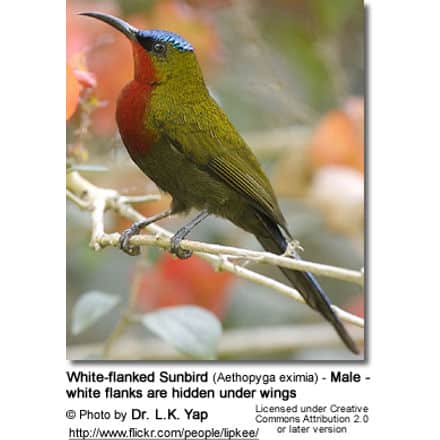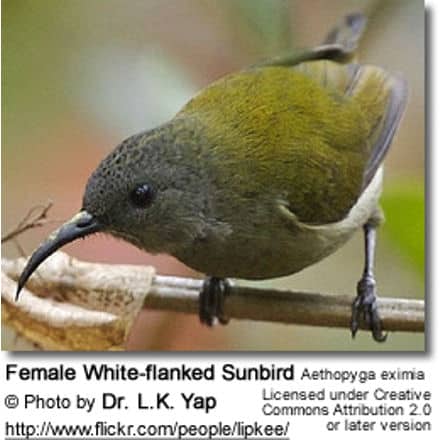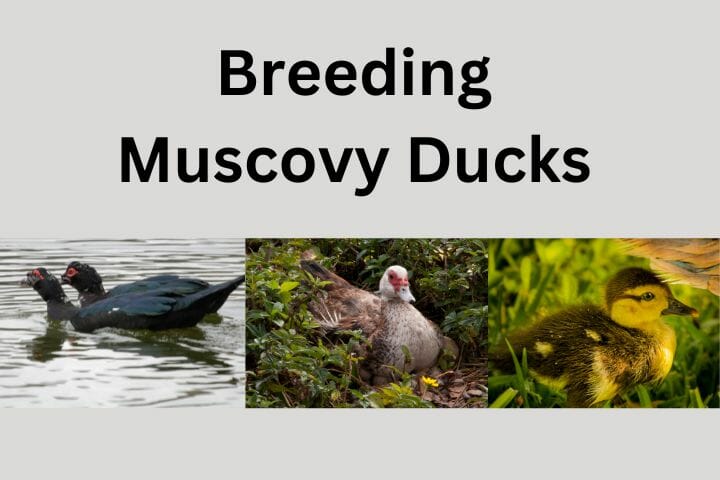White-flanked Sunbird (Aethopyga eximia) – Kuhl’s Sunbird
The White-flanked Sunbird (Aethopyga eximia) – also known as Kuhl’s Sunbird – occurs naturally only in the mountains of the Indonesian island of Java, from 4,000 feet (~ 1,200 meters) up to 10,000 feet (~3,000 meters). Within its limited range, this species is described as locally common, particularly at higher altitudes.
This species is most easily found in the Gede-Pangrango National Park; however, these birds are generally shy and restless and not easily observed.
These nectar-feeders often move low in areas with small, stunted trees, forests, and along trails and in clearings, foraging on the flowers of various trees, bushes, and undergrowth.

Description
Size
The White-flanked Sunbird measures about 5.1 inches or 13 cm in length, including the tail.
Plumage Details / Adults
This bird was named for its white flanks which offers the best method of identifying this bird, provided the white flanks aren’t covered by their wings. The male has a bluish crown and reddish-brown throat and chest, with some purplish feathers below the throat.
Other Physical Details
The long thin down-curved bill and brush-tipped tubular tongue are both adaptations to this bird’s nectar-feeding habits.
Gender ID
The female’s plumage is a duller olive-color, lighter below.
Juvenile Description
Immature birds resemble the adult female.

Diet / Feeding
White-flanked Sunbirds mostly feed on nectar, although take insects, particularly during the breeding season to feed their young and to satisfy their own need for increased protein in their diet during this demanding time.
They favor flowers with the highest sugar content and seek out those areas containing flowers with high-energy nectar.
The males establish feeding territories on flower-bearing shrubs and trees, which they aggressively defend.
Many native and cultivated plants on whose flowers sunbirds feed heavily rely on them for pollination. The mostly tubular-shaped flowers exclude most bees and butterflies from feeding on them and, subsequently, from pollinating the plants.
Breeding / Nesting
The White-flanked Sunbird male and female build the purse-shaped, moss-covered nest together – although the female takes on the part of lining the nest. The nest is often suspended from a thin branch of a low tree or shrub.
The average clutch consists of 2 – 3 eggs which are mostly incubated by the female for about 18 – 19 days. The male assists with feeding the young.
Calls / Vocalizations / Sounds
Its voice is described as a high-pitched chattering “tee-tee-tee.“
Sound Recording / Avocet
Alternate (Global) Names
Chinese: ????? … Czech: Sstrdimil b?loboký / jávský … Danish: Hvidflanket Solfugl … Dutch: Javaanse Honingzuiger … Finnish: Jaavanmedestäjä … French: Souimanga de Java / de Kuhl … German: Java Necktarvogel, Kavan … Indonesian: Burung madu gunung … Italian: Nettarinia di Kuhl / fianchibianchi … Japanese: Shirofusataiyouchou … Norwegian: Hvitflankesolfugl … Polish: Kwiatownik bialoboczny … Russian: ???????? ???????????? ?????????? … Slovak: nektárovka bieloboká … Spanish: Nectarina de Kuhl, Suimanga Eximio … Swedish: Vitflankad solfågel








